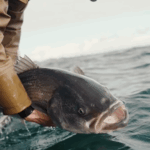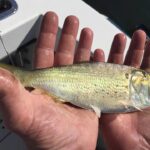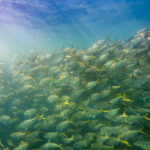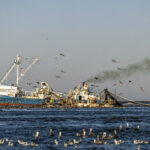
Release Mortality Revisited: New Research from Massachusetts DMF
Feature Photo Credit: Robbie Tartaglia What’s going on? For decades, striped bass management relied on a
The results were unanimous when the vote came down at the ASMFC May meeting of the Striped Bass Board to start Addendum II. This consensus to turn the page to the next chapter of striper management was directly driven by the amplified voices of the community. You drove that effort with your letters, emails, and hearing attendance. It was impressive and you should feel proud. During that campaign we were told to trust the process and that the tide was turning towards conservation. We’ve been in this game far too long to trust any commitment as absolute. Unfortunately, our pessimism is often proven correct, as it was earlier this week.
With information gathered over the last couple of days, we’ve come to the realization that a new dance from the mid-Atlantic is in the process of being choreographed. The playbook for Maryland, New Jersey, and Delaware at the meeting on August 1st can be summarized in a single statement: “kick the can down the road.” This blog provides a brief breakdown of why a delayed Addendum II process could be a nightmare outcome for striped bass.
While numbers are not finalized, we’re confident the 2023 spawn is bad – most likely really bad. While the survey is still going on, everyone knows that you can garner a good indication within the first few weeks of the Juvenile Abundance Index sampling. No matter how hard Maryland DNR tries to lock down the information, people still talk. We’ve seen this trend in past years. Our conversations in recent weeks have yielded the following:
The Upper Bay tributaries did not produce. The Potomac did not produce. The Chester River did not produce. The Patuxent pretty much blanked. The bellwether is the Choptank. It flows as a great reference point for annual performance. From all indications, the Choptank River did not produce either.
The implications of this combined lack of production are crucial. This will be five years in a row of poor recruitment. When the numbers are released, this will be a first in the history of striped bass record-keeping. You can bet yourself one thing: if we’re aware of these juvenile numbers, Maryland DNR is most definitely aware. Yet their plan for the August meeting is to wait for the stock assessment update in 2024 to make changes and buy themselves another year to protect special interests over the resource.
In 2014, the Maryland commercial striped bass quota was increased by 14%. In 2015, while the Ocean took a 25% reduction, the Chesapeake only took a 20.5% reduction. Essentially, Maryland commercial fishing took about a 5% reduction with reference to the previous year’s increase. Since that point in time, there have been so many management actions for striped bass, all driving reductions whose weight has been carried by other sectors and the rest of the coast. Chesapeake bay commercial striped bass fishing took a whopping 1.8% reduction from 2015-2023. That’s it. In the grand scheme of all the other changes and challenges that face this fishery, you can essentially round 1.8% down to 0%. While the ocean commercial fleet has contributed to conservation, the Bay has done nothing. Combine this trend with a mode split for the charter fleet in Maryland that allowed them to harvest two fish per person per day and we’ve fed a beast with a boundless appetite. The culmination of these dynamics led to the charter fleet in Maryland killing more fish than the charter fleet in the rest of the Bay and the Ocean combined.
We know that Cape Cod and areas of New York have experienced outstanding this season. We’ve seen beautiful photos of fish landed along the coast of Maine. Hearing these claims may sound crazy to anglers up north who are enjoying a bounty of localized abundance. We must remember that this is one single connected stock. If you want to understand just how bad it is in the Chesapeake, scroll to pg 31 of the REVIEW OF THE INTERSTATE FISHERY MANAGEMENT PLAN. Go to the bottom of the chart and look at the release mortality for the Chesapeake. It is the lowest ever recorded. That is all you need to know. The fishing effort continues to tank downwards because there are no fish in large regions of the bay. Certainly, some will claim that Maryland’s two-week closure in July is the reason for this. Add that punchline to your jokebook. The driving force behind these record-low release numbers is simple: no one is fishing these waters anymore because there are no stripers to catch.
Let us also observe that coastwide catch and release mortality numbers have fallen to just 39% of total fishing mortality. This drastically changes the conversation about balancing accountability by sector. In other words, C&R mortality isn’t the marquee problem anymore. Fishing effort has fallen through the floor in the Chesapeake. Are they going to suggest a two-week closure is going to account for a 70% reduction in catch and release mortality from 2006? There are no fish – and when we say “no fish”, don’t get fired up and direct message us a video of a blitz last Saturday where your boat caught 29 fish in 2 hours. We do not manage striped bass to the magic of a singular fishing experience. We should be managing to what many of us know this fishery can and should be. We should manage with abundance as the goal. All our lives are better with more fish in the water, including commercial anglers. The charter fleet has been reduced to pitching live spot under industrial piers in Baltimore Harbor because that is where the last school is holding.
For all of our members in areas that are having a good season, we have a harsh reminder for you:
This directly impacts you, and it is coming to you. Five years of terrible spawns will hit full force in 2027. After that, striped bass numbers will fall off a cliff. We continue to try to shine a light on the monster sitting in the darkness in the corner of a dark room, while those solely focused on their own interests keep switching off the lights.
We know that Emergency Action (EA) isn’t going to fix this fishery. We knew that when it was approved. That doesn’t change the fact that it was a historic, courageous and conservation-focused effort by the board. Even so, they never intended for the EA to be a “fix”. The goal of the EA was to stop the bleeding and provide some partial blocking for a crucial year class we’ll need to rely on to get out of the darkness. There needs to be a 16% reduction in harvest on top of the Emergency Action if there is any hope of lowering fishing mortality to an acceptable level. Harvest in the Chesapeake has to be severely curtailed. This is the fifth-straight bad year class they are fishing on. How can any fish hope to recruit to the ocean while having to maneuver its way through a 3-million-pound commercial quota that has gone unchanged since 2015? How can the depleted numbers sustain carve-outs for the charter fleet? We would seriously love an answer to that. How?
The most shocking thing about this whole scenario is that Maryland is fully aware of the poor spawning situation. They are the ones doing the surveys! Yet they spend their time trying to game the system so they can get one more year of unsustainable harvest on the books. It has left us almost speechless. There is a new Governor in Maryland. There is a new Secretary at Maryland DNR. There is a new Fisheries Director. We had a very, very minimal level of cautious optimism for change, but some things never do.
As always, we will remain on the frontlines and do our best to keep you all informed. We will be listening to and recording the meeting next Tuesday. We will make the commissioners own every single word they say. We need the conservation-minded states to stand up to this effort. They are the voice of those who prioritize abundance and the future of this fishery. Maryland and New Jersey have gotten pass after pass with striped bass. We always avoid “the word” whenever we can. We’ve never called for it. We do not want it. With the way all of this is trending, it’s really hard not to acknowledge that we are working our way toward a moratorium in the next four years. That should horrify all parties, sectors and stakeholders involved.
Feature Photo: Bill LeCony

Feature Photo Credit: Robbie Tartaglia What’s going on? For decades, striped bass management relied on a

Recent developments in the 2025 Atlantic Menhaden Stock Assessment Update, released by the Atlantic States

What’s going on? The “most important fish in the sea” just exposed one of the

Mario CampoFisheries Ecologist, Southeastern Louisiana UniversityScience and Policy Associate, American Saltwater Guides Association This discussion
We rely on our members and donations to keep fighting for a sustainable tomorrow in marine conservation.
GIVE THE GIFT OF FISHERIES CONSERVATION THIS HOLIDAY SEASON. SHOP ASGA GOODS THAT FUND FISHERIES RESEARCH & ADVOCACY CAMPAIGNS
JOIN ASGA IN CALLING FOR CRITICAL MANAGEMENT ACTION AFTER YEARS OF SPAWN FAILURES & POOR MANAGEMENT.
By using this website, you agree to our use of cookies. We use cookies to provide you with a great experience and to help our website run effectively. To learn more, please review our privacy policy.
4 Responses
Depressing. This is what happens in an era when science and expertise is vilified.
Remember that Maryland vilified catch and release in order for the charter fleet to get 2 fish per person while recreational angler and guides lost days on the water. They took extra credit for no target closures when the TC does not give extra credit.
Appreciate another great write up as always. This is tough news ~ but let’s continue to focus on what we can do and continue like we have to get creative in doing so.